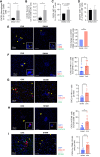Estrogen Receptor Blockade Potentiates Immunotherapy for Liver Metastases by Altering the Liver Immunosuppressive Microenvironment
- PMID: 39007345
- PMCID: PMC11306998
- DOI: 10.1158/2767-9764.CRC-24-0196
Estrogen Receptor Blockade Potentiates Immunotherapy for Liver Metastases by Altering the Liver Immunosuppressive Microenvironment
Abstract
Liver metastases (LM) remain a major cause of cancer-related death and are a major clinical challenge. LM and the female sex are predictors of a poorer response to immunotherapy but the underlying mechanisms remain unclear. We previously reported on a sexual dimorphism in the control of the tumor microenvironment (TME) of colorectal carcinoma liver metastases (CRCLM) and identified estrogen as a regulator of an immunosuppressive TME in the liver. Here we aimed to assess the effect of estrogen deprivation on the cytokine/chemokine profile associated with CRCLM, using a multiplex cytokine array and the RNAscope technology, and its effects on the innate and adaptive immune responses in the liver. We also evaluated the benefit of combining the selective estrogen-receptor degrader Fulvestrant with immune checkpoint blockade for the treatment of CRCLM. We show that estrogen depletion altered the cytokine/chemokine repertoire of the liver, decreased macrophage polarization, as reflected in reduced accumulation of tumor infiltrating M2 macrophages and increased the accumulation of CCL5+/CCR5+ CD8+ T and NKT cells in the liver TME. Similar results were obtained in a murine pancreatic ductal adenocarcinoma model. Importantly, treatment with Fulvestrant also increased the accumulation of CD8+CCL5+, CD8+CCR5+ T and NK cells in the liver TME and enhanced the therapeutic benefit of anti-PD1 immunotherapy, resulting in a significant reduction in the outgrowth of LM. Taken together, our results show that estrogen regulates immune cell recruitment to the liver and suggest that inhibition of estrogen action could potentiate the tumor-inhibitory effect of immunotherapy in hormone-independent and immunotherapy-resistant metastatic cancer.
Significance: The immune microenvironment of the liver plays a major role in controlling the expansion of hepatic metastases and is regulated by estrogen. We show that treatment of tumor-bearing mice with an estrogen receptor degrader potentiated an anti-metastatic effect of immunotherapy. Our results provide mechanistic insight into clinical findings and a rationale for evaluating the efficacy of combination anti-estrogen and immunotherapy for prevention and/or treatment of hepatic metastases in female patients.
©2024 The Authors; Published by the American Association for Cancer Research.
Conflict of interest statement
P. Brodt reports grants from Canadian Institute for Health Research during the conduct of the study. No disclosures were reported by the other authors.
Figures








References
-
- Siegel RL, Jakubowski CD, Fedewa SA, Davis A, Azad NS. Colorectal cancer in the young: epidemiology, prevention, management. Am Soc Clin Oncol Educ Book 2020;40:1–14. - PubMed
-
- Wu Y, Xu W, Wang L. IDDF2021-ABS-0191 gender matters: sex disparities in colorectal cancer liver metastasis survival: a population-based study. Gut 2021;70:A142–3.
-
- Miller KD, Nogueira L, Mariotto AB, Rowland JH, Yabroff KR, Alfano CM, et al. . Cancer treatment and survivorship statistics, 2019. CA Cancer J Clin 2019;69:363–85. - PubMed
-
- Siegel R, Naishadham D, Jemal A. Cancer statistics, 2012. CA Cancer J Clin 2012;62:10–29. - PubMed
Publication types
MeSH terms
Substances
LinkOut - more resources
Full Text Sources
Medical
Research Materials

